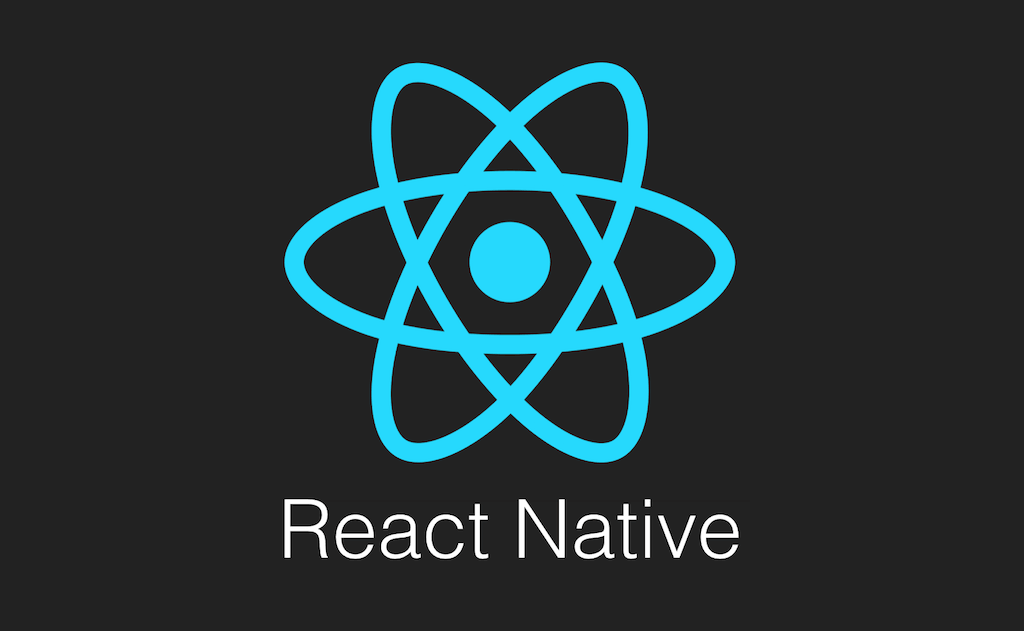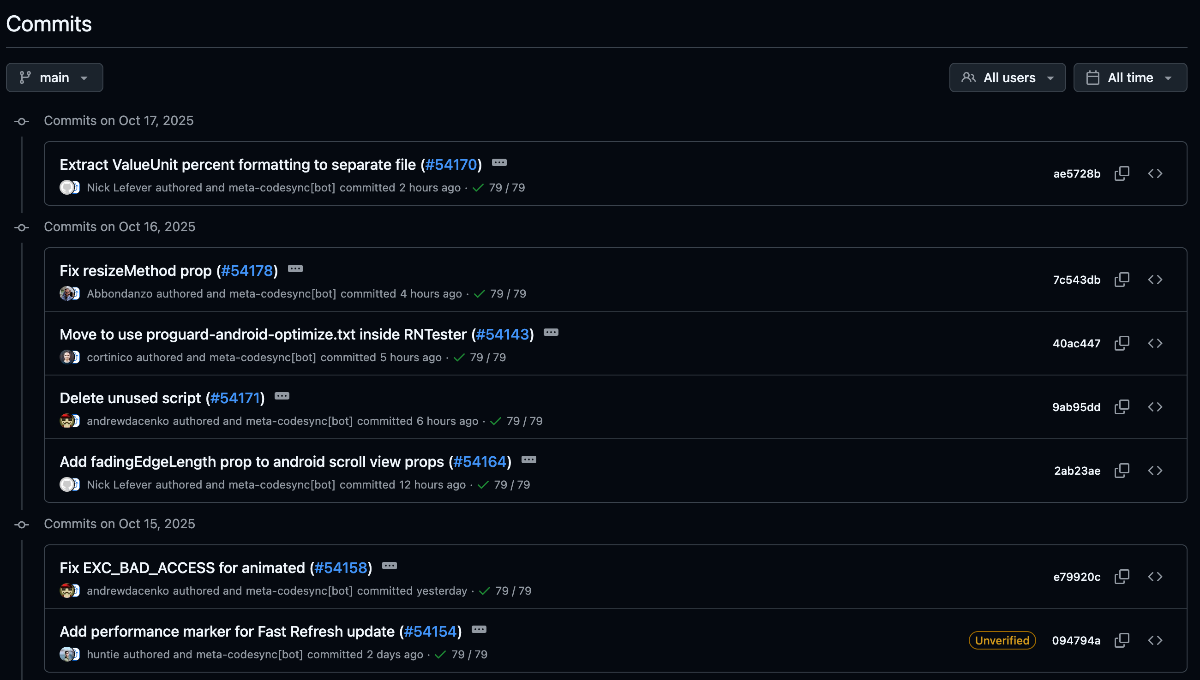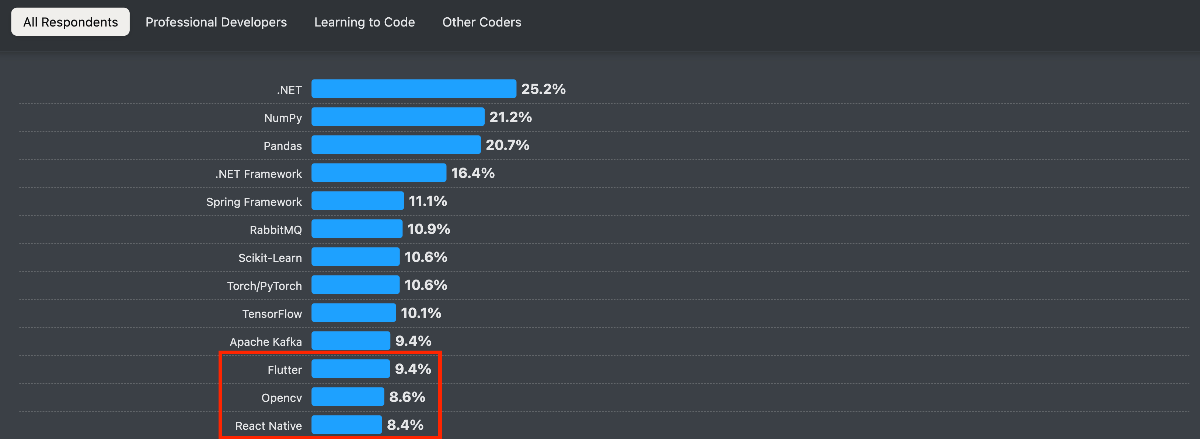React Native Is Dead? Support Discontinued? Not at All.
Even today, many people still believe that React Native is no longer supported — or even that it’s a “dead technology.”
This is simply not true. In fact, React Native continues to be actively updated and maintained.
Wait… there are still so many people who think React Native has been discontinued?
Why Do People Think React Native Is Dead?
Meta, the company that created React Native, recently developed its new app Threads using primarily native technologies (Swift, Kotlin, and Jetpack Compose).
Because of this, the rumor spread that “even Meta has abandoned React Native,” which led to the belief that the framework was on its way out.
However, this is only half true.
It’s correct that the core screens of the Threads app are native.
According to an analysis by Emerge Tools,
Threads uses Swift (and some Objective-C) on iOS, and Kotlin/Jetpack Compose on Android.
The apps are largely native, using a mix of Swift on iOS (and a little Objective C), and Jetpack Compose on Android (with Kotlin and Java as languages). There are some shared server-rendered screens for some simple experiences, but native is the norm.
— Technology choices and engineering approaches
Some developers on Reddit have claimed that when decompiling the Facebook app,
they found that it contained almost no React Native code and was mostly native
(source).
However, this contrasts with statements from Meta engineers themselves,
who continue to emphasize that React Native is actively used within Meta.
In Reality, Meta Actively Uses React Native
Instagram Uses It Extensively!
According to the Instagram Engineering Blog,
React Native significantly improved the team’s development velocity.
In early 2016, Instagram started experimenting with React Native to see if
they could reuse code between iOS and Android while shipping features faster.
The engineering team admitted that integrating React Native into an existing native app was much harder than building a new one,
but they started small — by porting the Push Notification Settings screen.
That screen had originally been implemented in a WebView, making it a perfect candidate to test whether React Native could improve startup performance.
As a result, Instagram engineers confirmed several advantages of React Native:
- With Hot Reloading and Live Reloading, they could see code changes instantly — no compile-and-install cycles needed.
- Code reuse rates were extremely high, allowing for simultaneous feature releases on both platforms. For example:* Post Promote — 99%* SMS Captcha Checkpoint — 97%* Comment Moderation — 85%* Lead Gen Ads — 87%* Push Notification Settings — 92%
- React Native features had faster startup times and better UX quality compared to WebView versions.
Since then, Instagram has ported additional features — Edit Profile, Photos Of, Post Promote, Save, Comment Moderation, and Lead Gen Ads —
achieving near-native performance while greatly accelerating development.
Facebook Uses It Too!
React Native is not some experimental technology; it’s a core part of Meta’s internal development stack, still widely used across key services.
In the official Meta blog post Meet the Developers – React @ Meta Edition,
Blair Vanderhoof, a frontend engineer on the Facebook Marketplace team, said that
he has been building and improving Marketplace features using React Native for over seven years.
He explained:
“At Facebook Marketplace, I’ve built many features with React Native — including the Seller Hub, product detail page animations, feed item UIs, and the counterpart profile screen.”
“I prefer to control the UI entirely with JavaScript, so I write very little native code — most of it is built in React.”
— Blair Vanderhoof, Frontend Engineer at Meta
In other words, Facebook Marketplace is one of Meta’s flagship products built largely with React Native.
The Marketplace team works closely with the React Native infrastructure team inside Meta,
using React Native + PanResponder API to implement complex animations, gestures, and transitions.
Blair also emphasized that React Native has enabled Marketplace to grow quickly
while providing rich, interactive UIs that meet the needs of both buyers and sellers.
Meta has used React Native as a standard mobile technology stack for years now,
integrating React Hooks, Context API, and Relay — key parts of the modern React ecosystem — directly into mobile workflows.
In short, contrary to the rumor that “Meta abandoned React Native,”
React Native is still actively used in production-level Meta apps like Facebook Marketplace,
and Meta engineers continue to contribute to its development and evolution.
Of course, it’s understandable that public perception and official positions differ — Meta naturally promotes its own tech. 😉
So, Meta Hasn’t Abandoned React Native
Meta hasn’t completely ditched React Native — it simply chooses the right tool for each product.
Most engineers agree that apps written purely in native languages often perform best,
but React Native was designed for cross-platform efficiency,
allowing developers to build both iOS and Android apps with a single codebase — a huge advantage.
For teams already familiar with React, this is even more powerful:
they can reuse their existing knowledge and ecosystem to expand from web to mobile.
That means smaller teams and tighter budgets can still build MVPs or extend their products to mobile cost-effectively —
making React Native a practical, efficient alternative.
React Native is still being actively updated and features regularly at major React conferences.
React Native Connection 2025
📍 April 3 (Reanimated Training) + April 4 (Conference), 2025 – Paris, France
Website | X | Bluesky
React Native London Conf 2024
📍 November 14–15, 2024 – London, UK (In-person)
Website | Twitter
React Native EU 2023
📍 September 7–8, 2023 – Wrocław, Poland
Website | Twitter | Facebook
React Native EU 2022: Powered by Callstack
📍 September 1–2, 2022 – Online Event
Website | Twitter | LinkedIn | Facebook | Instagram
Now, React Native isn’t the only cross-platform solution —
the most common comparison is with Flutter.
React Native vs Flutter
React Native and Flutter have long been rivals in the cross-platform space.
While React Native faced some reputation challenges, Flutter has been on the rise recently — that’s undeniable.
| Category | React Native | Flutter |
|---|---|---|
| Developer / Release Year | Meta (Facebook) / 2013 | Google / 2017 |
| Language | JavaScript + JSX | Dart |
| Rendering Architecture | Uses a JavaScript Bridge to call native components (Flux architecture) | Uses the Skia 2D rendering engine for its own UI rendering |
| UI Composition | Calls native UI components and connects them to JS | Uses Flutter’s widget system for fully consistent UI |
| Hot Reload | Supported (includes Live Reload) | Supported (faster and more stable) |
| 3D Graphics Support | Stronger (easier native API access) | Limited (focused on 2D widgets) |
| Performance | Slight overhead due to JS Bridge | Near-native performance (compiled to ARM code) |
| Ecosystem / Community | Large and mature — vast third-party library ecosystem | Growing fast, but still smaller overall |
| Documentation / Official Resources | Simple official docs but heavily third-party dependent | Well-structured Google-maintained documentation |
| Installation | Easy with Node.js + npm | Requires SDK download and environment setup (more complex) |
| Testing Tools | Requires third-party tools (e.g., Detox) | Built-in testing (Unit, Widget, Integration) |
| Learning Curve | Easier — uses JavaScript | Requires learning Dart (extra learning curve) |
| Major Adopters | Meta (Facebook, Instagram), Uber, Walmart | Google, Alibaba, BMW, eBay |
| Average Salary (US) | $93,000/year | $89,000/year |
| Strengths | ✅ JavaScript familiarity | |
| ✅ Uses native UI elements | ||
| ✅ Huge community | ✅ Consistent UI | |
| ✅ High-performance rendering | ||
| ✅ Integrated testing | ||
| Weaknesses | ❌ Performance overhead via Bridge | |
| ❌ Dependency management complexity | ||
| ❌ Inconsistent docs | ❌ Dart learning curve | |
| ❌ Larger app size | ||
| ❌ Some native API limitations |
Source: React Native vs Flutter in 2025 — Make the RIGHT Choice (Difference Explained)
Which Framework Should You Choose?
React Native and Flutter come from different philosophies,
but they share the same goal — build once, deploy everywhere (Android and iOS).
Both are highly productive frameworks, but the best choice depends on your team’s tech stack and project needs.
✅ When to Choose React Native
- Your team is already comfortable with JavaScript or the React ecosystem.
- You want to reuse existing web code or extend React-based UIs to mobile.
- You value the huge open-source community and available libraries.
- Proven by large-scale companies like Meta, Instagram, Uber, and Walmart.
✅ When to Choose Flutter
- You prioritize design consistency or have a complex UI to build.
- Though Dart has a learning curve, it enables multi-platform deployment (Android, iOS, Web, Desktop).
- The Skia engine provides GPU-accelerated high-performance rendering — great for apps needing smooth animations or modern visual UIs.
- Ideal for design-heavy tools, visualization apps, or startups building MVPs quickly.
In 2025, There’s No “Right” Choice — Only Strategy
Ultimately, it’s not about which one wins.
React Native has stability backed by a mature ecosystem and proven track record,
while Flutter continues to expand rapidly with strong UI consistency and performance.
React Native remains the most widely used cross-platform framework in production,
while Flutter has become the performance leader for design-centric apps.
When choosing between them, consider your project scale, team expertise, deployment environment, and maintenance strategy —
decide whether to go with React Native for pragmatic speed and flexibility,
or Flutter for long-term UI consistency and performance.
So What’s the Goal of This Article?
With all the criticism around React Native — and the growing tendency to recommend Flutter to every new developer —
I wanted to present a balanced perspective.
The decision is yours, but if negative rumors have made you hesitate to try React Native,
I hope this post helps you see the bigger picture. 😉
(That said… I’m off to learn Flutter now.)




